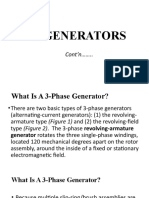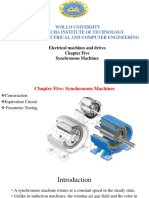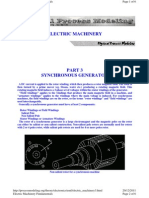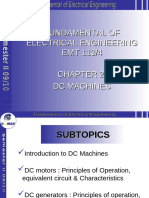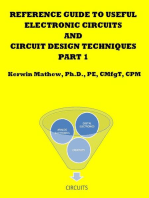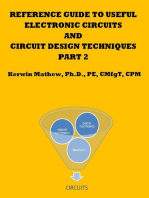Fundamental Gen Sink 2
Fundamental Gen Sink 2
Uploaded by
Sincere AchmadCopyright:
Available Formats
Fundamental Gen Sink 2
Fundamental Gen Sink 2
Uploaded by
Sincere AchmadOriginal Description:
Copyright
Available Formats
Share this document
Did you find this document useful?
Is this content inappropriate?
Copyright:
Available Formats
Fundamental Gen Sink 2
Fundamental Gen Sink 2
Uploaded by
Sincere AchmadCopyright:
Available Formats
1
Concordia University
Department of Electrical and
Computer Engineering
ELEC-331
Lecture 8
Synchronous generators (5.1-5.5)
Outline of the lecture
Synchronous generator construction
The rotor circuit
The speed of rotation and the frequency of the
electrical power
An equivalent circuit for a synchronous generator
The phasor diagram
Voltage regulation (isolated generator) and
reactive power control (grid connected) as a
function of the field current.
2
Synchronous generator
A prime mover (diesel engine or turbine) is
connected to the shaft (rotor) to supply mechanical
power.
A dc current is applied to the rotor or field
winding producing a rotating magnetic field (B
r
).
A 3 set of voltages is induced on the stator or
armature windings.
Elementary Synchronous generator
Voltage is induced on the 3 windings placed on the stator by the
variation of the magnetic flux.
The rotating magnetic field is created by the dc current appliedto the
field winding on the spinning rotor!
3
The rotor circuit (magnet)
2 and 4-pole machines have nonsalient (cylindri-
cal) poles while machines with 4 or more poles
have salient (sticking out) poles.
The rotor circuit (magnet)
Dc current is supplied to the rotor by means of slip
rings and brushes.
4
A brushless exciter system
The dc current that appears on the rotor is obtained from a
rectified induced voltage.
Another brushless exciter system
Notice the small pilot exciter (extra windings, permanent
magnet and rectifiers).
5
The speed of rotation of a synchronous
generator
The electrical frequency is synchronized to the rotor speed
Recall that the magnetic field created by a 3 4-pole
machine moves 180
o
while the stator currents vary 360
o.
Therefore, a 2-pole generator must turn at 3600 r/min to
produce a 60 Hz voltage while a 4-pole must turn at 1500
r/min to produce 50 Hz power.
120
) (# min) / (
) (
P r n
Hz f
m
e
=
The induced voltage
The internal generated voltage (no load) is:
How can this voltage be varied?
rad/s electrical in given is n whe
2
,
C
A
N
K K E = =
6
The output voltage of the generator
Factors that affect the output voltage ( V
):
- Armature reaction. Field created by the stator or
armature currents.
- Self-inductance and resistance of the stator
windings.
These can be modeled by an inductive reactance
and resistance in series with the internal
generated voltage
Equivalent model of a 3 synchronous
generator
A A A S A
I R I jX E V =
7
The per-phase equivalent circuit and
phasor diagrams
How does V
vary with the load type?
A A A S A
I R I jX E V =
You might also like
- Physics 2 Lab Worksheet Spring 2019-2020Document16 pagesPhysics 2 Lab Worksheet Spring 2019-2020isaac mejia martinez100% (1)
- Tapcon®260 AvcDocument12 pagesTapcon®260 Avcm khNo ratings yet
- Fault Code 154 Intake Manifold Air Pressure/Temperature Sensor Circuit - Voltage Below Normal or Shorted To Low SourceDocument12 pagesFault Code 154 Intake Manifold Air Pressure/Temperature Sensor Circuit - Voltage Below Normal or Shorted To Low SourceAhmedmah100% (2)
- Synchronous Generator I PDFDocument38 pagesSynchronous Generator I PDFjcrodriguez8367% (3)
- Synchronous Generator PART ADocument34 pagesSynchronous Generator PART Apayal100% (1)
- Bab 3 - Generator ListrikDocument56 pagesBab 3 - Generator Listrikmhafidz49No ratings yet
- Module Name:Electrical Machine I Module Code: Elt213: by AMAHIRWE Jean ClaudeDocument30 pagesModule Name:Electrical Machine I Module Code: Elt213: by AMAHIRWE Jean ClaudeOmar DjazzoNo ratings yet
- AC Machine Lecture No6Document43 pagesAC Machine Lecture No6Mohammed Dyhia AliNo ratings yet
- Synchronous Generator Lecture NoteDocument15 pagesSynchronous Generator Lecture NoteoyianonymousNo ratings yet
- Lecture 1 - Construction of Synchronous GeneratorDocument11 pagesLecture 1 - Construction of Synchronous GeneratorNdapewelao Mbwale100% (1)
- Syncgronous Generator UpdatedDocument78 pagesSyncgronous Generator UpdatedarsalNo ratings yet
- EM CH-4-5-6 Ac MachinesDocument80 pagesEM CH-4-5-6 Ac Machinesmuhammad.anas2007No ratings yet
- Synchronous MotorsDocument12 pagesSynchronous MotorsKaitlyn StylesNo ratings yet
- C5 SyncMachineDocument25 pagesC5 SyncMachineBassemGhorabNo ratings yet
- Chapter 5ADocument20 pagesChapter 5ASloom NusiratNo ratings yet
- Lecture 1 Machine IIIDocument24 pagesLecture 1 Machine IIIfrankmogul12No ratings yet
- Ac GeneratorsDocument46 pagesAc GeneratorsShairra Niña Chiu RodriguezNo ratings yet
- 6-Kontrol Generator SinkronDocument56 pages6-Kontrol Generator SinkronMuhamad Risqi AbdullohNo ratings yet
- Ch5 Synchronous MachineDocument106 pagesCh5 Synchronous MachineVeli GörgülüNo ratings yet
- Chapter-5 Synchronous MacineDocument30 pagesChapter-5 Synchronous MacineAman BazeNo ratings yet
- E M II: Synchronous MachineDocument10 pagesE M II: Synchronous MachineAkashman Shakya100% (1)
- AC Machine FundamentalsDocument24 pagesAC Machine FundamentalsKimsairng CheaNo ratings yet
- Lecture 7 - Synchronous Generators PDFDocument38 pagesLecture 7 - Synchronous Generators PDFMd Rodi BidinNo ratings yet
- EM214Synchronousmotor-Chapter 4Document62 pagesEM214Synchronousmotor-Chapter 4mahrus100% (1)
- Synchronous Generators 1Document50 pagesSynchronous Generators 1api-264713836100% (1)
- Chapter4 Synchronous MachinesDocument34 pagesChapter4 Synchronous Machinessatyakar_vvk100% (3)
- CH - 5 Synchronous MachinesDocument28 pagesCH - 5 Synchronous MachinesNAHOM ANTENEHNo ratings yet
- Synchronous GeneratorsDocument50 pagesSynchronous GeneratorsRajAnandNo ratings yet
- 1DC Motor - Separated and ShuntDocument22 pages1DC Motor - Separated and ShuntKasiye KebedeNo ratings yet
- Electrical Machines 2 AC MachinesDocument654 pagesElectrical Machines 2 AC Machinesgokulchandru89% (19)
- Lecture Notes Elec A6: Induction MachinesDocument39 pagesLecture Notes Elec A6: Induction MachinesRam PrasadNo ratings yet
- Synchronus Generator allDocument55 pagesSynchronus Generator alldarazrhr612No ratings yet
- AlternatorsDocument71 pagesAlternatorsnoveas u. eroisaNo ratings yet
- Synchronous Generators: Instructional ObjectivesDocument18 pagesSynchronous Generators: Instructional Objectivessanthosh2009No ratings yet
- Introduction To Electric MotorsDocument121 pagesIntroduction To Electric MotorsAmged AlbazeliNo ratings yet
- Chapter 4 - Synchronous GeneratorsDocument21 pagesChapter 4 - Synchronous Generatorsnehme0% (1)
- AC Drives: Dr. Adel A. El-Samahy Department of Electrical Engineering University of HelwanDocument25 pagesAC Drives: Dr. Adel A. El-Samahy Department of Electrical Engineering University of Helwanadelelsamahy5958No ratings yet
- Lecture#5Document35 pagesLecture#520pwmct0739No ratings yet
- Fundamental of Electrical Engineering EMT 113/4 DC MachinesDocument64 pagesFundamental of Electrical Engineering EMT 113/4 DC Machinesluiz pauloNo ratings yet
- Chapter 5 Machine 1Document44 pagesChapter 5 Machine 1martazemeduNo ratings yet
- Unit 2- DC MACHINES(Ppt Full Module)Document76 pagesUnit 2- DC MACHINES(Ppt Full Module)hotelvlogger26No ratings yet
- Pilot ExciterDocument6 pagesPilot ExciterRudy HerreraNo ratings yet
- IX Synchronous Machines Synchronous MachDocument51 pagesIX Synchronous Machines Synchronous Machedwin1eddy1No ratings yet
- Chapter 5 - AC Electrical MachinesDocument31 pagesChapter 5 - AC Electrical MachinesIqhfan HarisNo ratings yet
- 6931158Document64 pages6931158Saad2222No ratings yet
- Eee 205-W1Document24 pagesEee 205-W1mahamudul hasan100% (1)
- Motor NotesDocument9 pagesMotor NotesDay Nonz GetinoNo ratings yet
- Investigatory ProjectDocument18 pagesInvestigatory ProjectMohit NarulaNo ratings yet
- Lecture 10 & 11 Three Phase Induction MotorDocument28 pagesLecture 10 & 11 Three Phase Induction MotorMohamed HosamNo ratings yet
- Chap3 Ac MachinesDocument54 pagesChap3 Ac MachinesAbel Zermeño MuñozNo ratings yet
- Chapter 5 - Synchronous Generator: The Effect of Load Changes On A Synchronous Generator Operating AloneDocument46 pagesChapter 5 - Synchronous Generator: The Effect of Load Changes On A Synchronous Generator Operating AloneMuhammad R Shihadeh100% (1)
- Synchronous MachinesDocument17 pagesSynchronous Machinesaswardi8756No ratings yet
- Ac GeneratorsDocument7 pagesAc GeneratorsAnkur SheelNo ratings yet
- Reference Guide To Useful Electronic Circuits And Circuit Design Techniques - Part 1From EverandReference Guide To Useful Electronic Circuits And Circuit Design Techniques - Part 1Rating: 2.5 out of 5 stars2.5/5 (3)
- Simulation of Some Power Electronics Case Studies in Matlab Simpowersystem BlocksetFrom EverandSimulation of Some Power Electronics Case Studies in Matlab Simpowersystem BlocksetRating: 2 out of 5 stars2/5 (1)
- Simulation of Some Power Electronics Case Studies in Matlab Simpowersystem BlocksetFrom EverandSimulation of Some Power Electronics Case Studies in Matlab Simpowersystem BlocksetNo ratings yet
- Some Power Electronics Case Studies Using Matlab Simpowersystem BlocksetFrom EverandSome Power Electronics Case Studies Using Matlab Simpowersystem BlocksetNo ratings yet
- Reference Guide To Useful Electronic Circuits And Circuit Design Techniques - Part 2From EverandReference Guide To Useful Electronic Circuits And Circuit Design Techniques - Part 2No ratings yet
- Power System Transient Analysis: Theory and Practice using Simulation Programs (ATP-EMTP)From EverandPower System Transient Analysis: Theory and Practice using Simulation Programs (ATP-EMTP)No ratings yet
- Electrical Machines: Lecture Notes for Electrical Machines CourseFrom EverandElectrical Machines: Lecture Notes for Electrical Machines CourseNo ratings yet
- A New System of Alternating Current Motors and Transformers and Other EssaysFrom EverandA New System of Alternating Current Motors and Transformers and Other EssaysRating: 5 out of 5 stars5/5 (1)
- Advanced Electric Drives: Analysis, Control, and Modeling Using MATLAB / SimulinkFrom EverandAdvanced Electric Drives: Analysis, Control, and Modeling Using MATLAB / SimulinkNo ratings yet
- STUDENTDocument3 pagesSTUDENTSMple officialNo ratings yet
- 0i Model C-Maint ManualDocument700 pages0i Model C-Maint ManualAmudha BoobalanNo ratings yet
- Protek 6506Document1 pageProtek 6506Vanesa IriondoNo ratings yet
- Welding, Cutting & Allied Processes and Arc Welding Power Sources (Welding Machines)Document56 pagesWelding, Cutting & Allied Processes and Arc Welding Power Sources (Welding Machines)Prashant Kumar mishraNo ratings yet
- Current, Resistance, and Electromotive Force: Goals For Chapter 25Document9 pagesCurrent, Resistance, and Electromotive Force: Goals For Chapter 25Thắng PhạmNo ratings yet
- Emf of battery=ε=12 VDocument13 pagesEmf of battery=ε=12 VRajendirakumar RamaiahNo ratings yet
- Transformer XII Physics Investigatory Project-PDFDocument16 pagesTransformer XII Physics Investigatory Project-PDFpavanbansal336No ratings yet
- Cold ElectricityDocument10 pagesCold ElectricityPierre CorbeilNo ratings yet
- Series Circuits Ws 2Document4 pagesSeries Circuits Ws 2Afework TewoldeNo ratings yet
- NEMA Frames Application Manual: Basic Motor Terminology and TheoryDocument19 pagesNEMA Frames Application Manual: Basic Motor Terminology and Theorydk24991No ratings yet
- 620535379-Parallel-Plate-CapacitorsDocument18 pages620535379-Parallel-Plate-CapacitorsPankaj ChoudharyNo ratings yet
- U490BDocument7 pagesU490BmedyaaktuelNo ratings yet
- 32.power System Study-Sc, RC & Dynamic TestingDocument136 pages32.power System Study-Sc, RC & Dynamic TestingAbhishek Kulshreshtha100% (2)
- AQA Circuits 2Document64 pagesAQA Circuits 2nedugusNo ratings yet
- 03 75 To 100 MM Borewell Submersible PumpsetDocument17 pages03 75 To 100 MM Borewell Submersible PumpsetSelvamNo ratings yet
- Reed's Basic Electrotechnology For Engineers PDFDocument311 pagesReed's Basic Electrotechnology For Engineers PDFraovisam100% (2)
- Diagnostic Fault Codes: Quick Reference GuideDocument2 pagesDiagnostic Fault Codes: Quick Reference GuideJavier VillelaNo ratings yet
- Chapter ThreeDocument91 pagesChapter ThreeEthio Dangote TubeNo ratings yet
- Transformer Questions: Q1. The Diagram Shows The Apparatus Used by A Student To Investigate A TransformerDocument4 pagesTransformer Questions: Q1. The Diagram Shows The Apparatus Used by A Student To Investigate A TransformerJessicaNo ratings yet
- Practical File: Applied SciencesDocument12 pagesPractical File: Applied Scienceschikni babliNo ratings yet
- Vacuum Bottle Breaker Application and Testing GuideDocument6 pagesVacuum Bottle Breaker Application and Testing GuidefernandoquecaNo ratings yet
- H250 H250 H250 H250: Variable Area FlowmeterDocument88 pagesH250 H250 H250 H250: Variable Area Flowmetercedar1015No ratings yet
- Distortion of Travelling Waves by CoronaDocument8 pagesDistortion of Travelling Waves by CoronaKeris KeriNo ratings yet
- Servo and Proportional ValvesDocument19 pagesServo and Proportional ValvesRabah AmidiNo ratings yet
- HV ManualDocument88 pagesHV ManualVeeranji Reddy Nagireddy100% (1)
- PEKA 1 Ohms Law FM5Document5 pagesPEKA 1 Ohms Law FM5Nur Syafiqah Abu BakarNo ratings yet
- Adamson University College of Engineering Electrical Engineering DepartmentDocument8 pagesAdamson University College of Engineering Electrical Engineering DepartmentJohnBenedictRazNo ratings yet
















